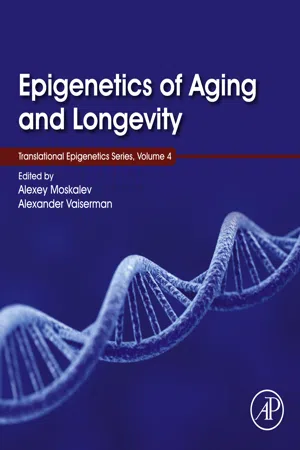
Epigenetics of Aging and Longevity
Translational Epigenetics vol 4
- 544 pages
- English
- ePUB (mobile friendly)
- Available on iOS & Android
Epigenetics of Aging and Longevity
Translational Epigenetics vol 4
About this book
Epigenetics of Aging and Longevity provides an in-depth analysis of the epigenetic nature of aging and the role of epigenetic factors in mediating the link between early-life experiences and life-course health and aging. Chapters from leading international contributors explore the effect of adverse conditions in early-life that may result in disrupted epigenetic pathways, as well as the potential to correct these disrupted pathways via targeted therapeutic interventions. Intergenerational epigenetic inheritance, epigenetic drug discovery, and the role of epigenetic mechanisms in regulating specific age-associated illnesses—including cancer and cardiovascular, metabolic, and neurodegenerative diseases—are explored in detail.This book will help researchers in genomic medicine, epigenetics, and biogerontology better understand the epigenetic determinants of aging and longevity, and ultimately aid in developing therapeutics to extend the human life-span and treat age-related disease.- Offers a comprehensive overview of the epigenetic nature of aging, as well as the impact of epigenetic factors on longevity and regulating age-related disease- Provides readers with clinical and epidemiological evidence for the role of epigenetic mechanisms in mediating the link between early-life experiences, life-course health and aging trajectory- Applies current knowledge of epigenetic regulatory pathways towards developing therapeutic interventions for age-related diseases and extending the human lifespan
Frequently asked questions
- Essential is ideal for learners and professionals who enjoy exploring a wide range of subjects. Access the Essential Library with 800,000+ trusted titles and best-sellers across business, personal growth, and the humanities. Includes unlimited reading time and Standard Read Aloud voice.
- Complete: Perfect for advanced learners and researchers needing full, unrestricted access. Unlock 1.4M+ books across hundreds of subjects, including academic and specialized titles. The Complete Plan also includes advanced features like Premium Read Aloud and Research Assistant.
Please note we cannot support devices running on iOS 13 and Android 7 or earlier. Learn more about using the app.
Information
Aging Epigenetics
Changes and Challenges
Abstract
Keywords
1. Introduction
2. Epigenetic Alterations and the Aging Process
2.1. The ‘Aging Epigenome’
Table of contents
- Cover image
- Title page
- Table of Contents
- Translational Epigenetics Series
- Copyright
- List of Contributors
- Preface
- Section 1. Epigenetic Mechanisms in Aging
- Section 2. Early-Life Epigenetic Programming of Aging Trajectories
- Section 3. Epigenetics of Aging-Associated Diseases
- Section 4. Epigenome-Targeted Therapies in Gerocscience
- Section 5. Conclusions and Perspectives
- Index